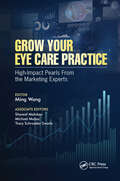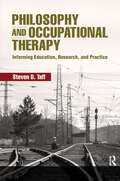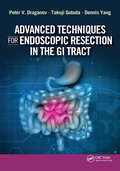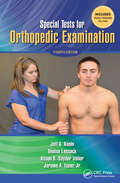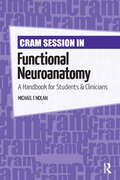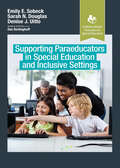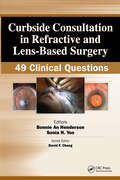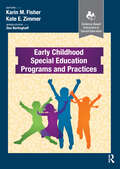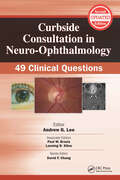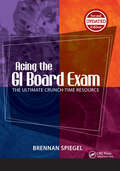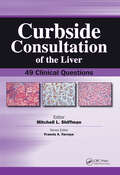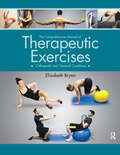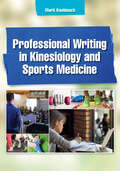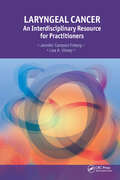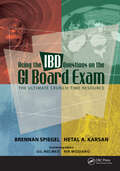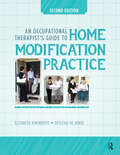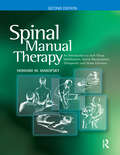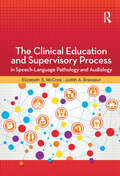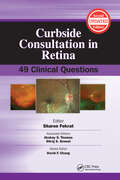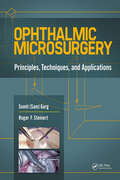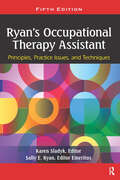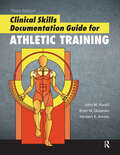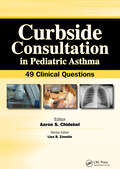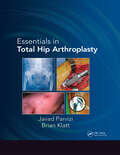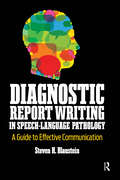- Table View
- List View
Grow Your Eye Care Practice: High Impact Pearls from the Marketing Experts
by Ming WangA crash course in marketing for eye care professionals, Grow Your Eye Care Practice: High Impact Pearls from the Marketing Experts guides readers through this crucial area of business development.With an increase in patients undergoing elective procedures and an increase in the amount of providers, marketing has become the most important way for eye care professionals to grow their practices and differentiate themselves from their competition. Since marketing is not addressed in any formal course in medical school, optometry school, residency or fellowship, many eye care professionals lack basic understanding and skills in this area of growing importance to their businesses.To meet this critical need, editor Dr. Ming Wang and associate editors Shareef Mahdavi, Michael Malley and Dr. Tracy Swartz have created this essential, timely handbook aggregating the key ophthalmic marketing pearls, teachings and experiences of some of the leading national and international marketing experts.Grow Your Eye Care Practice begins with an overview of the history and current state of ophthalmic marketing, including a fascinating look at the commoditization of eye care as was demonstrated with the introduction of LASIK. The core chapters address foundational and innovative marketing concepts and their application to eye care, including: Market research, segmentation, targeting and positioning Patient experience Branding versus call to action Word of mouth referrals Digital marketing, including social media, websites and SEO Innovative marketing approaches Ethics and laws governing medical marketing Upcoming disruptive marketing technologies Grow Your Eye Care Practice: High Impact Pearls from the Marketing Experts is an indispensable desktop reference for all eye care professionals--ophthalmologists, optometrists, administrators, practice managers, business associates, residents, fellows, medical students and optometry students—who wish to improve their marketing skills, grow their practices and differentiate themselves from their competition.
Philosophy and Occupational Therapy: Informing Education, Research, and Practice
by Steven TaffPhilosophy and Occupational Therapy: Informing Education, Research, and Practice provides an overview of the most influential philosophical movements from past to present and shows how these philosophies are a foundational, yet underutilized, element of occupational therapy education, research, and practice. Editor Steven D. Taff, PhD, OTR/L, FNAP, FAOTA, fills a gap in existing occupational therapy literature by exploring the major thinkers and concepts of numerous different philosophical movements and examining their implications. Taff and a multitude of chapter authors demonstrate that the vital points of human existence are found in philosophy as well as science, and that occupational therapy should incorporate a clearly articulated philosophical perspective into its evidence-based and measurement-driven paradigm. Each chapter offers a basic description of a philosophy, outlines major thinkers and concepts and ultimately summarizes the implications for occupational therapy education, research and practice. Philosophy and Occupational Therapy: Informing Education, Research, and Practice is a unique and essential book for occupational therapy educators, researchers, and clinicians that will enrich the teaching-learning process, ground research with depth and clarity, and spark discussion among professionals about reviving the use of philosophy in current occupational therapy practice.
Advanced Techniques for Endoscopic Resection in the GI Tract
by Dennis Yang Peter Draganov Takuji GotodaSurgery has traditionally been the standard of care for the treatment of neoplastic lesions in the gastrointestinal tract. With advances in endoscopic resection techniques, there has been a paradigm shift in how to approach many of these precancerous and early cancerous lesions. Potential advantages of endoscopic resection include its minimally invasiveness which often translates into quicker patient recovery. In recent years, there have been major strides in safety and efficacy of minimally invasive endoscopic approaches with ongoing advances in therapeutic endoscopy. Advanced Techniques for Endoscopic Resection in the GI Tract by Drs. Peter V. Draganov, Takuji Gotoda, and Dennis J. Yang provides an in-depth analysis of the current state of advanced endoscopic techniques for the evaluation and resection in the gastrointestinal tract. Each chapter in the book addresses specific topics such as: endoscopic evaluation of lesions technical aspects of the procedure management of adverse events post-procedural care and follow-up Advanced Techniques for Endoscopic Resection in the GI Tract provides a comprehensive review of all the different aspects of advanced endoscopic resection in the gastrointestinal tract which makes it ideal for interventional GI endoscopists and general gastroenterologists, as well as surgeons.
Special Tests for Orthopedic Examination
by Jeff G. Konin Denise Lebsack Alison Valier Jerome A. Isear, Jr.First published more than 20 years ago, Special Tests for Orthopedic Examination, now in its Fourth Edition, continues to follow the authors’ initial goals of providing a simple, pocket-sized manual for practical learning purposes. The Fourth Edition provides critical and invaluable information on the most current and practical special tests used during an orthopedic examination. The efficient user-friendly, spiral-bound format allows for easy access to individualized special tests. Special Tests for Orthopedic Examination, Fourth Edition includes 160 special tests, 6 of which are new: Ballottement Test Gerber’s Test (Lift-Off Test) Painful Arc Sign Thessaly Test Quad Active Test Lelli Test for Anterior Cruciate Ligament (ACL) Injuries Inside Special Tests for Orthopedic Examination Fourth Edition, Jeff G. Konin, Denise Lebsack, Alison R. Snyder Valier, and Jerome A. Isear, Jr. have included a new section on evidence, where the authors have highlighted systematic reviews, meta-analyses, or single articles to address reliability, sensitivity, and specificity of the special tests, where available. What is new and updated in the Fourth Edition: Includes a video website that provides visually enhanced dimensional and motion analysis of each special test performed Includes 160 special tests, 6 of which are new to this edition Includes information on reliability, sensitivity, and specificity presented in a table format New evidence section highlight systematic reviews, meta-analyses, or single articles for special tests, where available New color images for each test Updated references for all tests Bonus Material!Special Tests for Orthopedic Examination, Fourth Edition includes a video website with each new book purchase. This video website offers a unique approach that provides a visually enhanced dimensional and motion analysis of each special test performed. The video segments will help students and clinicians better understand the test motion in order to perform the test accurately during an orthopedic examination. The simple yet succinct information provided throughout the manual and on the video website will help clinicians make informed decisions during an orthopedic examination, from understanding to performing and evaluating the special tests. Special Tests for Orthopedic Examination, Fourth Edition will carry on the tradition of past editions as being the premier resource for thousands of students, clinicians, and rehabilitation professionals.
Cram Session in Functional Neuroanatomy: A Handbook for Students & Clinicians
by Michael NolanWhen all you need is a basic understanding of the human nervous system, look to Cram Session in Functional Neuroanatomy: A Handbook for Students & Clinicians.This handbook gives you basic information in a readily accessible format, as well as more detailed concepts that will allow you to better understand not only how the human nervous system works, but how injuries and disease affect experience and behavior, including cognitive and intellectual functions.Cram Session in Functional Neuroanatomy: A Handbook for Students & Clinicians by Dr. Michael F. Nolan is a concise and illustrated quick reference that highlights important anatomical and physiological principles of the nervous system. These key points will enhance understanding of the nervous system and how specific populations of nerve cells and neural systems influence human experience and behavior.WHAT IS IN YOUR CRAM SESSION?• Concise and focused explanations of topics specifically related to neuroanatomy • Topic self-assessment questions formatted as short answer exercises, ideal for exam review and preparation• List of laboratory structures – an excellent tool to aid faculty with additional methods of learning• More than 75 photographs and illustrations Included with the text are online supplemental materials for faculty use in the classroom.Cram Session in Functional Neuroanatomy: A Handbook for Students & Clinicians is a perfect text for physical therapy students and other medical and health professionals in neurology and neurosurgery.
Supporting Paraeducators in Special Education and Inclusive Settings (Evidence-Based Instruction in Special Education)
by Sarah Douglas Emily Sobeck Denise UittoSupporting Paraeducators in Special Education and Inclusive Settings provides an in-depth look at the role of pre- and in-service teachers as supervisors of paraeducators within special education and inclusive settings.The latest entry within the Evidence-Based Instruction in Special Education series, Supporting Paraeducators in Special Education and Inclusive Settings serves as an instructional tool for pre-service teachers and educators within higher education coursework, as well as a resource for in-service teachers. This text supports teachers in strengthening their knowledge and supervisory skills necessary to supervise and manage paraeducators in educational environments.Through objectives, scenarios, content, and chapter questions, Drs. Sobeck, Douglas, and Uitto provide a thorough and applicable overview of working with and supervising paraeducators. In this text the roles and responsibilities of paraeducators, teachers, and school administrators relative to paraeducator training and supervision will be detailed, as well as tips for collaboration.Included with the text are online supplemental materials for faculty use. School leaders and higher education faculty can use the online site for materials to support pre-service training within teacher preparation programs and professional development for in-service teachers.Supporting Paraeducators in Special Education and Inclusive Settings fills an important need in the field and is a vital resource for current and future teachers when working with paraeducators.
Curbside Consultation in Refractive and Lens-Based Surgery: 49 Clinical Questions (Curbside Consultation in Ophthalmology)
by Bonnie An Henderson Sonia H. YooAre you looking for concise, practical answers to questions that are often left unanswered by traditional references on refractive surgery? Are you seeking brief, evidence-based advice for the daily examination of patients? Curbside Consultation in Refractive and Lens-Based Surgery: 49 Clinical Questions provides quick and direct answers to the thorny questions most commonly posed during a “curbside consultation” between experienced clinicians. Drs. Bonnie An Henderson and Sonia H. Yoo have designed this unique reference in which refractive specialists offer expert advice, preferences, and opinions on tough clinical questions commonly encountered by ophthalmologists, residents, and other health care professionals. The unique Q&A format provides quick access to current information related to refractive and lens-based surgery with the simplicity of a conversation between two colleagues. Images, diagrams, and references are included to enhance the text and to illustrate clinical diagnoses and treatment plans. Based on clinical scenarios that a refractive surgeon might encounter in real life, Curbside Consultation in Refractive and Lens-Based Surgery provides information basic enough for residents while also incorporating expert pearls that even high-volume ophthalmologists will appreciate. General ophthalmologists and residents alike will enjoy the user-friendly and casual format.Some of the questions that are answered: How do I manage epithelial ingrowth after LASIK? What if it recurs? Should I perform PRK in patients with forme fruste keratoconus? How do I manage patients with dry eyes after LASIK surgery? How do I determine my surgically induced astigmatism? Is a monocular implantation of a multifocal IOL tolerated? How do you manage an unhappy multifocal patient who is experiencing halos and glare?
Early Childhood Special Education Programs and Practices (Evidence-Based Instruction in Special Education)
by Karin Fisher Kate ZimmerEarly Childhood Special Education Programs and Practices is a special education textbook that prepares pre- and in-service teachers with the knowledge, skills, and dispositions to deliver evidence-based instruction to promote positive academic and behavioral outcomes for young children (prekindergarten through second grade) with development delays and/or disabilities.Early Childhood Special Education Programs and Practices intertwines inclusive early childhood practices by using real-life anecdotes to illustrate evidence-based practices (EBPs) and procedures. The authors, experts in their fields, emphasize high-leverage practices, EBPs, and culturally sustaining pedagogy and align them with the practices, skills, and competencies recommended by the Council for Exceptional Children’s Division for Early Childhood. Families, administrators, and teacher educators of pre- and in-service early childhood special education and general early childhood education programs alike will find this book useful.Included in Early Childhood Special Education Programs and Practices are: An overview of early childhood and development of children ages 4 to 8 Strategies for relationship building with students, families, communities, and school personnel Tips on creating a caring and positive classroom environment Chapters devoted to evidence-based instruction in core subjects of reading and writing, mathematics, science, and social studies for students with disabilities in pre-K to second grade More than 80 images, photos, tables, graphs, and case studies to illustrate recommended Practices Also included with the text are online supplemental materials for faculty use in the classroom, consisting of an Instructor’s Manual and PowerPoint slides.Created with the needs of early childhood special educators in mind, Early Childhood Special Education Programs and Practices provides pre- and in-service teachers with the skills and practices they need to serve young children, their families, and communities across settings.
Curbside Consultation in Neuro-Ophthalmology: 49 Clinical Questions (Curbside Consultation in Ophthalmology)
by Paul Brazis Andrew Lee Lanning B. KlineCurbside Consultation in Neuro-Ophthalmology has been updated into a Second Edition! The Second Edition contains new questions and is completely updated! Curbside Consultation in Neuro-Ophthalmology: 49 Clinical Questions, Second Edition contains new questions and brief, practical, evidence-based answers to the most frequently asked questions that are posed during a “curbside consultation” between surgical colleagues. Dr. Andrew G. Lee and associate editors Dr. Paul W. Brazis and Dr. Lanning B. Kline have designed this unique reference in which neuro-ophthalmologists offer expert advice, preferences, and opinions on tough clinical questions commonly associated with neuro-ophthalmology. The unique Q&A format provides quick access to current information related to neuro-ophthalmology with the simplicity of a conversation between two colleagues. Images, diagrams, and references are included to enhance the text and to illustrate common clinical dilemmas.Some of the questions that are answered inside theSecond Editioninclude: What is the evaluation for papilledema? What is the work up for third nerve palsy? What is the treatment for giant cell arteritis? What is the evaluation for optic disc edema with a macular star? What is the evaluation for anisocoria? Curbside Consultation in Neuro-Ophthalmology: 49 Clinical Questions, Second Edition provides information basic enough for residents while also incorporating expert pearls that even high-volume ophthalmologists will appreciate. Residents, fellows, and practicing physicians alike will benefit from the user-friendly, casual format and the expert advice contained within.
Acing the GI Board Exam: The Ultimate Crunch-Time Resource
by Brennan SpiegelAcing the GI Board Exam: The Ultimate Crunch-Time Resource has been updated into a Second Edition. The Second Edition contains new vignettes, a discussion on Maintenance of Certification (MOC) Exam, and discussion on test relevancy for residency rotations! In today’s fast-paced world, gastroenterology and hepatology residents and fellows struggle to find the time to study for the board exams, prepare for the recertification exam, prepare for teaching rounds, or just plain read. What is the best way to effectively prepare and study, if reading multiple resources can’t seem to fit into your daily schedule? The answer to your study questions (and study time!) can be found inside the newly updated Second Edition of Acing the GI Board Exam: The Ultimate Crunch-Time Resource! Why You Will Need to Read Acing the GI Board Exam, Second Edition: New! 41 new and carefully vetted board-style vignettes with color images New! Brief discussion on the Maintenance of Certification (MOC) Exam New! Discussion on test relevancy for residency rotations Comprehensive yet succinct answers using a high-yield format Emphasis on key clinical pearls and “board buzzwords” Answers to classic board “threshold values” questions that you need to know but always seem to forget Rapid-fire, crunch-time exam with 200 classic one-liners Dr. Brennan Spiegel has collected every pearl of wisdom, high-yield factlet, "Board buzzword," micrograph, and classic imaging study he could muster, all while keeping Acing the GI Board Exam: The Ultimate Crunch-Time Resource, Second Edition a manageable size. Acing the GI Board Exam, Second Edition fills the unmet need in board review by presenting time-tested and high-yield information in a rational, useful, and contextually appropriate format suitable studying for the board exams and preparing for the recertification exam.Chapters Include: A compilation of general lessons learned from past test-takers “Tough Stuff” board review vignettes Board review “Clinical Threshold Values” “Crunch-Time” Self-Test and Answer Guide—time to get your game on! With its focus on pearl after pearl, emphasis on images, and attention to high-yield “tough stuff” vignettes you don’t know the answers to (yet), Acing the GI Board Exam, Second Edition is truly the ultimate crunch-time resource for acing the GI and Hepatology examination, taking recertifying examinations, looking good on clerkship rounds, or for just challenging yourself with interesting and entertaining vignettes.
Curbside Consultation of the Liver: 49 Clinical Questions (Curbside Consultation in Gastroenterology)
by Mitchell L. ShiffmanAre you looking for concise, practical answers to questions that are often left unanswered by traditional liver references? Are you seeking brief, evidence-based advice for complicated cases or complications? Curbside Consultation of the Liver: 49 Clinical Questions provides quick and direct answers to the thorny questions commonly posed during a “curbside consultation” between colleagues.Dr. Mitchell Shiffman has designed this unique reference, which offers expert advice, preferences, and opinions on tough clinical questions commonly associated with the liver. The unique Q&A format provides quick access to current information related to the liver with the simplicity of a conversation between two colleagues. Numerous images, diagrams, and references are included to enhance the text and to illustrate the treatment of the liver.Curbside Consultation of the Liver: 49 Clinical Questions provides information basic enough for residents while also incorporating expert advice that even high-volume clinicians will appreciate. Gastroenterologists, fellows, residents in training, and medical students will benefit from the user-friendly and casual format and the expert advice contained within.Some of the questions that are answered: How often should I follow a patient who had chronic hepatitis C after they achieved a sustained virologic response? Should I stop the HIV medications in a patient who has developed an elevation in serum liver transaminases? What should I tell my patient who is a carrier for alpha-1-antitrypsin deficiency? Which patients with fatty liver disease on an ultrasound examination require a liver biopsy? Which patients with chronic liver disease should I screen for hepatocellular carcinoma? How much ascites is safe to remove at any time?
The Comprehensive Manual of Therapeutic Exercises: Orthopedic and General Conditions
by Elizabeth BryanTherapeutic exercises can be found spread out amongst numerous texts, handouts, card boxes, and websites, which has sent clinicians, practitioners, and trainers searching for reliable, evidence-based exercises for the entire body, all packaged into a single, all-inclusive manual. To that end, The Comprehensive Manual of Therapeutic Exercises: Orthopedic and General Conditions was written as a fundamental resource on exercise theory and techniques, and as a comprehensive guide for designing exercise programs. Dr. Elizabeth Bryan has compiled thousands of clinically relevant exercises to create a text that will teach students theory and proper application that they will then return to again and again in their career as a reference to aid in designing evidence-based exercise programs for their clients or patients. Introductory chapters cover exercise parameters, exercise progression, the importance of form, muscle soreness, and a reference for body position terminology, then subsequent chapters are organized by body area to cover most of the clinical exercises in use today. Each exercise includes photographs, a list of muscle systems that will be affected, specific substitutions to look for, and detailed instructions directed at students and clinicians. Also included are sections devoted to protocols and specialty exercises including yoga and tai chi. Embracing the principles of evidence-based practice, “Where’s the Evidence?” boxes are prominently featured throughout the text to support the exercises and theory with up-to-date, relevant, sufficient, valid, and reliable studies. Combining theory with practice, The Comprehensive Manual of Therapeutic Exercises: Orthopedic and General Conditions is an essential tool for students as well as clinicians, practitioners, or trainers to find the most appropriate exercises for their client’s or patient’s needs and apply them properly.
Professional Writing in Kinesiology and Sports Medicine
by Mark KnoblauchPublication of a research article can be a defining moment in a researcher’s career. However, the steps involved in turning an initial research question into a published article can be a long and arduous journey. To aid in this process, Professional Writing in Kinesiology and Sports Medicine was developed to serve as a comprehensive writing guide for research professionals and students who are looking to improve their academic writing skills. Dr. Mark Knoblauch and his 15 contributors developed Professional Writing in Kinesiology and Sports Medicine to focus around the area of manuscript development and presentation, while also including chapters that outline the foundational concepts of professional writing, developing a research grant, and the journal selection process. Each chapter is written by content experts who bring a wealth of experience not only from their own academic writing but also from having spent countless hours helping students become better, more effective writers. Many textbooks have been written that focus on development of the research manuscript itself, but what sets Professional Writing in Kinesiology and Sports Medicine apart is that it includes so much more to aid writers in their process.What you can find inside: Examination of ancillary aspects associated with academic research such as poster and oral presentations How to choose the most effective journal How to deal with the stress of writing How to write an effective grant Professional Writing in Kinesiology and Sports Medicine covers those topics and more, with the intent of providing a thorough, practical writing guide that spans the breadth of the research manuscript development, writing, and presentation process. Throughout the textbook, sample writings and cases relevant to the fields of kinesiology and sports medicine are used to provide the reader relevant, applicable examples to help improve their own writing.
Laryngeal Cancer: An Interdisciplinary Resource for Practitioners
by Jennifer Campion Friberg Lisa VinneyLaryngeal cancer is a complex medical condition, and its treatments, both surgical and nonsurgical, typically affect a variety of life functions. These complex consequences of laryngeal cancer necessitate that many different medical specialties work together as a cohesive, collaborative care team to support patients and their caregivers/families.Despite the interdisciplinary treatment that laryngeal cancer requires, many resources offer the perspective of only one specific profession. Laryngeal Cancer: An Interdisciplinary Resource for Practitioners caters to the team approach that is needed to provide patients with evidence-based treatment and maximize outcomes.To fill this need for an interdisciplinary text, Drs. Jennifer Campion Friberg and Lisa Vinney bring together a wide range of medical professionals to represent their unique perspectives on the treatment of patients with laryngeal cancer. Each chapter addresses a different critical aspect of the interdisciplinary care and how they impact the other aspects, written by experts in each field.Sample Chapters Include: Medical and Surgical Diagnosis Airway and Respiratory Challenges Nutrition and Swallowing Challenges Psychosocial Care of the Patient Bonus! A supplemental website is available for healthcare providers to share with their laryngeal cancer patients and their caregivers/families. This resource provides critical information about all aspects of their care and treatment, presented in a simple, digestible way for the layperson to understand.When the whole team of health care professionals involved in laryngeal cancer management understands the big picture of care, they can tailor individual treatment priorities to the needs of each unique patient and maximize quality of life. Because of this, Laryngeal Cancer: An Interdisciplinary Resource for Practitioners is designed to be a comprehensive guide for any professional involved in the many facets of interdisciplinary care for patients with laryngeal cancer.
Acing the IBD Questions on the GI Board Exam: The Ultimate Crunch-Time Resource
by Brennan Spiegel Hetal KarsanThe world of inflammatory bowel disease (IBD) knowledge is vast. Within that world is a sub-set of knowledge that is especially important for everyday clinical care. And a sub-set of that is testable for the Board exam. The testable material includes time-honored, locked-in-stone, mostly uncontroversial facts that have withstood the test of time. The answer to your study questions (and reduction of your study time!) can be found inside Acing the IBD Questions on the GI Board Exam: The Ultimate Crunch-Time ResourceUntil now, there has been no single, slim, but high-yield volume that summarizes the IBD you really need to know for the board exams, preparing for rounds, or just plain read. The authors have collected every pearl of wisdom, high-yield factlet, IBD "Board buzzword," micrograph, and classic imaging study they could muster, all while keeping Acing the IBD Questions on the GI Board Exam: The Ultimate Crunch-Time Resource a manageable size.In today’s fast-paced world it is hard to keep up with the burgeoning IBD literature. Traditional textbooks usually feature long and detailed discussions that don’t directly address board and recertification exams. On the flip side, many board review manuals provide lists and bullet points lacking sufficient background and context. Acing the IBD Questions on the GI Board Exam by Drs. Brennan Spiegel and Hetal Karsan, fills the unmet need in board review by presenting time-tested and high-yield information in a rational, useful, and contextually appropriate format.Why you need Acing the IBD Questions on the GI Board Exam:• Focuses exclusively on inflammatory bowel disease review• Carefully vetted board-style vignettes with color images• Comprehensive yet succinct answers using a high-yield format• Emphasis on key clinical pearls and “Board Buzzwords”• Rapid-fire crunch time exam with 140 classic one-liners such as:Diarrhea + mucus-filled cysts throughout colon = ?The vastly evolving world of IBD includes genetic breakthroughs and new medications with different risks and benefits. Acing the IBD Questions on the GI Board Exam has it all in one resource that includes endoscopic, histologic, radiologic and dermatologic manifestations, as well as with great images and tables to help guide the reader.Chapters include:• A compilation of general lessons learned from past test takers• “Tough Stuff” board review vignettes• “Crunch-Time” Self-Test—Time to get Your Game On! With its focus on pearl after pearl, emphasis on images, and attention to high-yield “tough stuff” vignettes you don’t know the answers to (yet), Acing the IBD Questions on the GI Board Exam: The Ultimate Crunch-Time Resource will help you ace the GI and recertifying examinations, look good on clerkship rounds, simply challenge you with interesting and entertaining vignettes, and take optimal care of your IBD patients in clinical practice.
An Occupational Therapist’s Guide to Home Modification Practice
by Elizabeth Ainsworth Desleigh de JongeOlder people and people with a disability have a right to be included in all aspects of home and community life, and yet, environmental barriers continue to exist in the built environment. There are concerns about how well homes can support older people and people with a disability over time as their needs change.Occupational therapists are well suited to determining the most appropriate home modification solutions to address environmental barriers. They possess the knowledge and skills necessary to evaluate people’s current and future needs in the context of the nature and use of the environment and can work collaboratively with design and construction professionals to develop solutions.To be comprehensive and effective in their approach, occupational therapists need to understand not only the individual’s requirements, but also, the ethical and legal contexts for practice, the technical aspects of the built environment, the relevance and intent of access standards and design approaches, and the application of a range of products and finishes.An Occupational Therapist’s Guide to Home Modification Practice, Second Edition by Elizabeth Ainsworth and Desleigh de Jonge and their team of expert contributors provides comprehensive information to inform occupational therapists about current practice and research. This includes the authors using a transactional approach to examine the person-occupation-environment interaction and providing occupational therapists with a detailed understanding of the various dimensions of the home environment that can impact on client’s home modification decisions.New material has been provided relating to research and practice issues, such as an overview of the latest home modification outcome research findings as documented in literature; an update on outcome evaluation; new research information about the dimensions of the home impacting on decision making; additional information grabrail and ramp prescription; and the inclusion of new case studies illustrating minor and major modification solutions for clients who present with diverse needs. In the Second Edition you’ll find: A detailed understanding of aspects of the home environment that impact home modification decisions A review of legislative environment and funding systems that facilitate service delivery An overview of home modification services, as well as future trends A range of comprehensive case studies — illustrated by photographs Additional theory to inform knowledge, and skill development, that can be used in home modification practice worldwide Included with the text are online supplemental materials for faculty use in the classroom..An Occupational Therapist’s Guide to Home Modification Practice, Second Edition provides a range of resources and tools, and it can be used as a teaching aid to support students, interns, and novice therapists or as a manual for reflection and practice for more experienced home modification practitioners.
Spinal Manual Therapy: An Introduction to Soft Tissue Mobilization, Spinal Manipulation, Therapeutic and Home Exercises
by Howard W. MakofskySpinal Manual Therapy: An Introduction to Soft Tissue Mobilization, Spinal Manipulation, Therapeutic and Home Exercises, Second Edition is an easy-to-follow manual of clinical techniques for the spine, pelvis, and temporomandibular joint. The text provides "tools" rather than "recipes" and immerses the reader in the process of "thinking as a manual therapist", rather than functioning as a technician. The clinical utility of this revised second edition combines the art and science of present day spinal manual therapy.The focus of Spinal Manual Therapy, Second Edition is to provide clinically useful treatment techniques, while being mindful of the scientific literature related to the practice of spinal manual therapy. It is an ideal resource for all those interested in grasping the basics of spinal manual therapy and transferring that knowledge into practice within a clinical environment.The hands-on approach taken by Dr. Howard W. Makofsky makes this new edition the go-to textbook for spinal manual therapy.New to the Second Edition: New pictures of examination and treatment techniques with captions Additional case studies New evidence supporting spinal manual therapy Updated references throughout the text This unique textbook has a plethora of clinical techniques, including the rationale for each of their use. With over 300 figures, illustrations, and photographs for each examination/treatment technique for various regions of the body, students and clinicians learning manual therapy will benefit greatly from Spinal Manual Therapy, Second Edition.Inside you’ll find: Evaluation Soft tissue techniques Manipulative procedures Specific exercises Clinical problem solving Spinal Manual Therapy, Second Edition mirrors a course on the introduction to spinal manual therapy and will be welcomed into physical therapy curriculums, as well as appreciated by clinicians when entering clinical practice.
The Clinical Education and Supervisory Process in Speech-Language Pathology and Audiology
by Elizabeth McCrea Judith BrasseurAs with the actual practices of speech-language pathologists and audiologists, clinical education and supervision practices work best when they are grounded not only in concept and theory but also in research. Designed to act as a complete guide to both the theory and the research, The Clinical Education and Supervisory Process in Speech-Language Pathology and Audiology provides the most up-to-date information on these crucial topics. Following in the footsteps of their mentor, Jean Anderson, Drs. Elizabeth McCrea and Judith Brasseur have taken on the task of assembling important current research and best practices in clinical education and supervision into one comprehensive resource. With their prestigious team of contributing authors, this text represents the culmination of decades of study and real-world best practices.The Clinical Education and Supervisory Process in Speech-Language Pathology and Audiology covers clinical education and supervision across five unique constituent groups: clinical educators of graduate students, preceptors of audiology externs, mentors of clinical fellows, supervisors of support personnel, and supervisors of professionals transitioning between work settings. It also includes the latest information on certification and accreditation requirements for preparation in supervision.Topics include Foundations: Anderson’s Continuum of Supervision Components of the Process Expectations for Supervision Practical Research in Supervision Literature from other Disciplines Obtaining Feedback About the Supervisory Process The Ethics of Clinical Education and Supervision Supervisor Self-Study and Accountability Interprofessional Education and Practice in Clinical Education and Supervision Chapter appendices add numerous ancillary materials, allowing readers to easily adopt the most successful processes and strategies the research has revealed. Sample scripts of supervisory conferences, self-assessment tools, action plan tools, and analysis systems can all be found inside.The Clinical Education and Supervisory Process in Speech-Language Pathology and Audiology is intended as a primary resource for anyone in those professions in any setting who is engaged in the process of clinical education and supervision. With this text as their guide, clinical educators and supervisors will be able to ground their practices in the vast compiled research and study contained within.
Curbside Consultation in Retina: 49 Clinical Questions (Curbside Consultation in Ophthalmology)
by Sharon FekratCurbside Consultation in Retina: 49 Clinical Questions has been updated into a Second Edition! The Second Edition contains new questions and is completely updated!Curbside Consultation in Retina: 49 Clinical Questions, Second Edition contains new questions and brief, practical, and evidence-based answers to the most frequently asked questions that are posed during a “curbside consultation” between surgical colleagues. Dr. Sharon Fekrat, along with associate editors Drs. Akshay Thomas and Dilraj Grewal, have designed this unique reference that offers expert advice, preferences, and opinions on a variety of clinical questions commonly associated with the retina. The unique Q&A format provides quick access to current information related to the retina with the simplicity of a conversation between two colleagues. Images and references are included to enhance the text and to illustrate clinical diagnoses. Some of the questions that are answered inside the Second Edition include: Anything coming down the pike yet for dry age-related macular degeneration? How long are we going to have to keep doing frequent intravitreal injections -- Any other options anytime soon? What are we waiting for? What is hemorrhagic occlusive retinal vasculitis and why do I need to know about it? Are we ever going to use stem cells? For what? What’s the scoop? I just can’t keep up with all of the clinical trial acronyms. Can you tell me what study each refers to? What systemic medications require periodic fundus evaluation, what am I looking for, and what tests do I do? Explain all of these new anticoagulants to me. Should I consider stopping them preoperatively? Curbside Consultation in Retina: 49 Clinical Questions, Second Edition provides information basic enough for residents while also incorporating expert pearls that even high-volume ophthalmologists and specialists will appreciate. Optometrists, ophthalmologists, ophthalmologists-in-training, and even retina specialists will benefit from the user-friendly and casual format as well as the expert advice contained within.
Ophthalmic Microsurgery: Principles, Techniques, and Applications
by Sumit Garg Roger SteinertExcellent microsurgery derives not from natural dexterity alone or from pure book knowledge, but from these features combined with an appreciation of the instrumentation, physical forces, and tissue reactions that create the environment of microsurgery. Ophthalmic Microsurgery: Principles, Techniques, and Applications conveys both the art and science of microsurgery from an ophthalmic perspective.This unique resource begins with the principles and techniques of microsurgery, which can be applied to all types of surgeries and includes detailed laboratory exercises to teach the key concepts. The second section of Ophthalmic Microsurgery addresses the specific applications. While not an encyclopedia of all surgical interventions, Drs. Sumit “Sam” Garg and Roger Steinert, along with their contributors, provide an overview of key surgical competencies that are relevant to the various ophthalmic subspecialties.Ophthalmic Microsurgery is set apart from other similar resources by having a comprehensive and concise focus on translating surgical principles into reality through simple and inexpensive exercises.Grounded in practicality and requiring only basic materials, Ophthalmic Microsurgery: Principles, Techniques, and Applications covers the theory and basics of microsurgery needed during the ophthalmic surgical training of residents and fellows and serves as an excellent manual for the more experienced ophthalmologists looking to refine their technique in microsurgery.
Ryan's Occupational Therapy Assistant: Principles, Practice Issues, and Techniques
by Karen SladykA renowned and cornerstone text for the occupational therapy assistant for more than 30 years is now available in an updated Fifth Edition. Continuing with a student-friendly format, the classic Ryan’s Occupational Therapy Assistant: Principles, Practice Issues, and Techniquescontinues to keep pace with the latest developments in occupational therapy, including the integration of key concepts from key documents for the occupational therapy profession, such as: AOTA’s Occupational Therapy Practice Framework, Third Edition ACOTE Standards Code of Ethics and Ethics Standards Guidelines for Supervision, Roles, and Responsibilities During the Delivery of Occupational Therapy Services Diagnostic and Statistical Manual of Mental Disorders, Fifth Edition (DSM-5) Building on the legacy work of Sally E. Ryan, Dr. Karen Sladyk presents more than 45 chapters in the Fifth Edition of Ryan’s Occupational Therapy Assistant. Using actual client examples, occupational therapy assistant (OTA) students are guided throughout the process of learning various principles and disabilities to applying that knowledge in a clinical setting. What is new inside the Fifth Edition: Two new chapters included in the Occupations and Disabilities section on Downs syndrome and diabetes and bipolar disorder Updates of each chapter throughout New evidence-based practice and supportive research throughout New color interior design throughout Updated references throughout Included with the text are online supplemental materials for faculty use in the classroom. Ryan’s Occupational Therapy Assistant, Fifth Edition includes a variety of treatment techniques that help students understand how to choose and when to implement certain procedures. Group intervention, assistive technology and adaptive equipment, basic splinting, wellness and health promotion, and work injury activities are examples of the techniques presented. This Fifth Edition also includes specific chapters about evidence-based practice and understanding research. Chapters on supervision, functional ethics, and professional development are examples geared toward educating OTA students on how to manage different aspects of their early career. A core text for students aspiring to become successful OTAs for more than 30 years, Ryan’s Occupational Therapy Assistant: Principles, Practice Issues, and Techniques, Fifth Edition is the leading textbook to have throughout one’s education and early career.
Clinical Skills Documentation Guide for Athletic Training
by John Hauth Brian Gloyeske Herb AmatoFor more than 15 years, Clinical Skills Documentation Guide for Athletic Training has been an invaluable resource for athletic training students to learn, practice, and master clinical skill sets throughout their educational career. A textbook that can be used from the start of their education up until graduation becomes essential to this learning process.Clinical Skills Documentation Guide for Athletic Training, Third Edition includes a more user-friendly layout for the student. Organized by the Athletic Training Education Competencies, Fifth Edition and the associated content areas, this Third Edition allows for easier integration into the classroom, laboratory activities, and clinical assessment.The organization of skills around Athletic Training Education Competencies, Fifth Edition, including crosswalk information from the latest BOC Role Delineation Study/Practice Analysis, Sixth Edition, aligns the skill sheets from Clinical Skills Documentation Guide for Athletic Training, Third Edition with commonly used texts and reference materials.What is in the Third Edition: A user-friendly layout organized by the Athletic Training Education Competencies, Fifth Edition and mapped by the BOC domains New clinical skill assessment forms in the areas of acute care, prevention and health promotion, and therapeutic interventions Includes references to specificity, sensitivity, and evidence-based practice guidelines where appropriate The Program Assessment chapter provides faculty with an excellent resource for tracking mastery of skills and program outcome achievement Instructor’s materials consist of online versions of the clinical integration proficiencies Included with the text are online supplemental materials for faculty use in the classroom.With an updated user-friendly layout and new clinical skill assessment forms, the Third Edition of Clinical Skills Documentation Guide for Athletic Training will be invaluable for students, faculty, clinical preceptors, and practicing athletic trainers who want to learn or enhance understanding and mastery of essential clinical skills.
Curbside Consultation in Pediatric Asthma: 49 Clinical Questions (Curbside Consultation in Pediatrics)
by Aaron ChidekelAre you looking for concise, practical answers to those questions that are often left unanswered by traditional pediatric asthma references? Are you seeking brief, evidence-based advice for complicated cases or controversial decisions? Curbside Consultation in Pediatric Asthma: 49 Clinical Questions provides quick answers to the tricky questions most commonly posed during a “curbside consultation” between pediatricians. Dr. Aaron Chidekel has designed this unique reference which offers expert advice, preferences, and opinions on tough clinical questions commonly associated with pediatric asthma. The unique Q&A format provides quick access to current information related to pediatric asthma with the simplicity of a conversation between two colleagues. Numerous images, diagrams, and references allow readers to browse large amounts of information in an expedited fashion. Some of the questions that are answered: • How is asthma diagnosed in infancy and childhood? • I am a busy pediatrician. How can I integrate effective asthma management into my practice?• What are the most current NIH asthma guidelines and what do I need to know about them?• What is an asthma action plan and how can one be individualized for my patients?• What do the parents of my patients need to know about asthma and its management?• How do I know when a patient with asthma should see a specialist?Curbside Consultation in Pediatric Asthma: 49 Clinical Questions provides information basic enough for residents while also incorporating expert advice that even high-volume pediatricians will appreciate. Pediatricians, nurse practitioners, physician assistants, and family practitioners will benefit from the user-friendly, casual format and the expert advice contained within.
Essentials in Total Hip Arthroplasty
by Javad Parvizi Brian KlattEssentials in Total Hip Arthroplasty by Dr. Javad Parvizi is a succinct, yet comprehensive text that provides a unique and colorful look into the world of total hip arthroplasty, an in-depth history of this common procedure, as well as strategies to treat and prevent complications.Inside you will find information on:• Patient selection• Preoperative templating• Surgical techniques• Relevant anesthesia and pain management• Postoperative rehabilitation• Strategies for minimization of complications• Relevant figures and diagrams• And much moreEssentials in Total Hip Arthroplasty is unique in its format to provide basic and detailed information on total hip arthroplasty from A to Z with descriptive, easy-to-read text and extensive visual elements, such as charts and tables.With total hip arthroplasty being the most successful and popular procedure and each chapter being written by both a resident and an attending, Essentials in Total Hip Arthroplasty will be the essential “go-to” text for residents, fellows, physical therapists, students, and junior attendings involved with all matters related to the procedure.
Diagnostic Report Writing In Speech-Language Pathology: A Guide to Effective Communication
by Steven BlausteinDesigned to improve the report writing skills of speech-language pathology students, communication sciences and disorders students, Clinical Fellows, and professionals alike, Diagnostic Report Writing in Speech-Language Pathology: A Guide to Effective Communication is a one-of-a-kind text entirely dedicated to the production of an effective diagnostic speech and language evaluation.In today’s academic and health care climate, accurate and clear documentation has never been more important. Diagnostic Report Writing in Speech-Language Pathology seeks to demystify and simplify the challenges many students and clinicians face while learning to write speech and language evaluations by combining the science and art of assessment with an effective presentation.Dr. Steven H. Blaustein uses his more than 50 years of experience as a clinician, consultant, and professor to logically guide the reader through the necessary steps involved in the documentation of a speech and language evaluation. From discussing the initial reason for the referral and case history to the final summary, impressions, and recommendations, each step of the writing process is clearly explained.Topics included in Diagnostic Report Writing in Speech-Language Pathology: Speech sound production Oral peripheral examinations Issues of law, fairness, and ethics Critical information for the approval of services and third-party reimbursement Common report writing errors to avoid Images and tables to illustrate the process of documenting a speech and language evaluation There is no one-size-fits-all template for documenting an evaluation. Diagnostic Report Writing in Speech-Language Pathology: A Guide to Effective Communication provides the reader with the skills and knowledge necessary to compile an effective professional report that meets the needs of patients, clients, students, and outside stakeholders.
